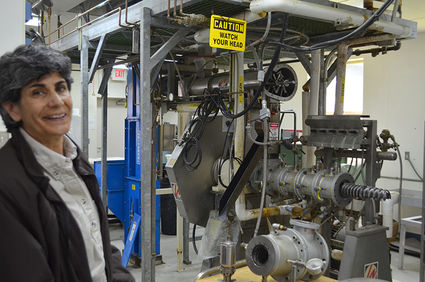Abernathy fish lab 1 of 7 in the country
June 30, 2016
There is a treasure trove of very smart, educated, and friendly people working at Abernathy Fish Technology Center, located at the end of Abernathy Creek Road.
It is one of only seven technology centers in the US. It is an applied science arm of the US Fish and Wildlife Service. The staff works to provide answers for tribes, power companies, universities, non-profits and others in Washington, Oregon, California, Nevada, and Idaho.
The center was once one of several fish hatcheries that produced salmon to mitigate any damage caused by the dams. According to Patty Crandall, the deputy center director, the center started doing research on nutrition in the 1960s. Nearly 30 years later, they were focused solely on research and no longer raising and releasing salmon.
"A lot of people remember us as a facility where a bunch of fifth graders would come out and watch them spawn fish," Crandall said.
Not any more, though there is still plenty to see.
"If someone has a scientific question with regards to primarily aquatics, we are prepared to answer some of their questions," Crandall said. "When they make decisions about different organisms we help provide scientific information. We don't make the decision, just provide the information."
All the technology centers in the US have to have one specialty. The one at the end of Abernathy Creek Road has three--conservation genetics, physiology and nutrition, and quantitative ecology and technology.
Each program has at least one PhD to run it and there are several scientists who do a variety of analyses and field work, according to Crandall.
"Most people have at least a master's degree," she said. "It's very nerdy around here. We are very fortunate."
There are several projects that are currently being done right now.
One scientist is studying lampreys, while others are tackling carp at the Malheur National Wildlife Refuge.
Scientists regularly receive genetic samples from fish hatcheries or others.
"In 24 hours we can tell a fish hatchery in California if they have fall or winter chinook," Crandall said. "They look the same, but winter chinook are endangered. They need to know the difference."
Bull trout are also threatened. When they get below a series of dams, people need to know which stream they came from so they can be returned to the area above the correct dam.
Another study involves suckers from the upper Klamath Lake.
"They are talking about pulling some of them into the hatchery because they don't seem to be reproducing any more in the lake," Crandall said. "Can we save some? If we do, what do we feed them?"
That's where scientists from the physiology and nutrition department step in.
"The only fish that are released from Abernathy are for research purposes," Crandall said. "Those are winter steelhead. We don't produce very many of them. We only produce enough so when they come back we can gather DNA from them. We have a very large project with the Washington Department of Fish and Wildlife about winter steelhead in Abernathy Creek."
They are comparing fish reared in Abernathy Creek to the fish reared at the facility.
"They are genetically identical," Crandall said. "We got our fish from the creek."
Genetically identical, but there are differences. That is one thing some of the scientists at AFTC are trying to understand and remedy.
"We are finding that our hatchery fish are becoming genetically more distinct from the wild fish after a couple generations," Crandall said. "We are trying to reverse some of those processes. We are trying to make our fish look and behave more like a native steelhead. Hatcheries all over are doing this sort of thing. They don't want their fish to be different from the wild fish, because the wild fish are better at surviving."
"The parents of the wild fish met and decided to reproduce," she added. "They weren't randomly selected like the hatchery fish."
The hatchery fish may be bigger, Crandall explained, while the fish in the streams seem to be more nervous, even paranoid. But the wild fish have had to survive and find their own food, unlike the hatchery fish which are being fed a healthy diet.
"A lot of places have a lab, a hatchery, or a creek, but we have all three and that's part of the reason why this facility has survived," Crandall said.
Photo Cutlines
1) Ann Gannam, a regional nutritionist for the US Fish and Wildlife Service, talks about the extruder behind her. She and her colleagues use it to create fish feed. "We take different ingredients and combine them. We formulate for a certain protein and lipid profile. We also a vitamins because these fish are in raceways or tanks where they aren't getting any other food. We have to give them a complete diet. If other people have ideas of what they want to test, we might formulate the diet for them or they send us a formulation and ask us to make it for them."
2) Lamprey spawn in the creek nearby. They eat detritus, junk off the bottom of the creek. James Barron, a fish biologist, is studying them. "What we have here is the larval stage. They start out in a stream like Abernathy Creek here, their parents built them a nest, they hatch, eventually they start burrowing. They say it can take up to seven years, they are filtering feed down there. Detritus, algae, whatever they can catch out of the water. Eventually they grow large enough and undergo a transformation, transitioning between larvae and juvenile. They head out to sea and start parasitizing, sucking on fish, and drinking their blood. After a couple years they come back as adults and hold in the river for one or two years before they decide to spawn. It's really a pretty neat life cycle." According to Barron, wherever there are salmon, there are lamprey.
3) Internal tags for fish. "If you are doing it right, it take five or 10 minutes a fish. They wake up from the surgery very well," Kyle Hanson said.
4) A lamprey at larval stage. Barron has become a master at catching them. "You won't see any fish in these tanks unless you look for them because there is sand in them." There has been a substantial decline of lamprey, according to Patty Crandell, the Deputy Center Director at Abernathy Fish Technology Center.
5) Puget Island resident and Biological Science Tech Kelli Hawke was busy cleaning a raceway at the Abernathy Fish Technology Center but took time out to share a laugh.
6) Kyle Hanson is the Regional Physiologist at AFTC. He's been involved in several studies. "We look at why animals live or die, why they are able to migrate or not able to migrate. Are we doing things to stress them out? By taking a blood sample, we can look at stress hormones, like cortisol, and use that to determine what is stressing out the fish. If a fish hatchery calls and says we've been handling fish and some of them are getting sick now, we can tell them why. We'll take blood samples at different points in the handling process and be able to tell them it's where you held the fish out of water, or it's where they went back into warm water." Hanson was also involved in a study involving smelt in the Cowlitz River. "Smelt are listed as threatened now. They are very fatty, they were a major portion of the diet of the native tribes and bands in the area. They come in in winter, when there aren't as many salmon. Very important to the tribe. In the past few decades their numbers have declined pretty dramatically. About four years ago, the run was...very few. So we worked with the Cowlitz who got a grant to research why there are so few smelt. We did two projects with them. Was there an impact from all the sediment from Mt. St. Helens? One of the theories they had was that these fish could be spawning but all their babies get covered in silt. We did an experiment where we got some fish from the tribe and we spawned them and then buried the eggs in known levels of sand. We left the eggs for about two weeks when they should have hatched." They learned that they weren't dying. What they didn't know was whether or not they were able to wriggle their way free of the silt and feed.
7) Doug Peterson, senior scientist and program head for the Quantitative Ecology and Technology Department, shows off an antenna used to collect data. "A lot of our projects are field based, which means we're busy out in the natural environment, collecting data for projects that run the gamut from looking at effects of invasive species on aquatic systems, to interactions between hatchery salmon and wild salmon, to looking at the effects of climate change on fish habitats, and the effects of climate change on built environments."

















Reader Comments(0)